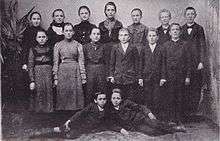Września
| Września | ||
|---|---|---|
|
Town hall | ||
| ||
 Września | ||
| Coordinates: 52°20′N 17°35′E / 52.333°N 17.583°E | ||
| Country |
| |
| Voivodeship | Greater Poland | |
| County | Września County | |
| Gmina | Gmina Września | |
| Established | 1256 | |
| Town rights | 1375 | |
| Government | ||
| • Mayor | Tomasz Kałużny | |
| Area | ||
| • Total | 12.73 km2 (4.92 sq mi) | |
| Highest elevation | 110 m (360 ft) | |
| Lowest elevation | 90 m (300 ft) | |
| Population (2006) | ||
| • Total | 28,617 | |
| • Density | 2,200/km2 (5,800/sq mi) | |
| Time zone | CET (UTC+1) | |
| • Summer (DST) | CEST (UTC+2) | |
| Postal code | 62-300 | |
| Area code(s) | +48 61 | |
| Car plates | PWR | |
| Website | http://www.wrzesnia.pl | |
Września [ˈvʐɛɕɲa] (German: Wreschen) is a town in west-central Poland with 28,600 inhabitants (1995). It is situated in the Września County, Greater Poland Voivodeship (since 1999), previously in Poznań Voivodeship (1975–1998), on the Wrześnica River.
History
The city was first mentioned in 1256. Early sources speak of Wressna (1317) or Wresna (1364). Września was granted town privileges in the 14th century. The town was burned down 1664 (other sources speak of 1656) in the war against Sweden. The majority of inhabitants were Poles, but since mid-17th century there have also been German settlements. The city was annexed by the Kingdom of Prussia in 1793, following the Second Partition of Poland. In 1807 it became part of the Duchy of Warsaw, but fell back to Prussia in 1815.

Września is known in Poland for a school strike by Polish children in May 1901 in response to the intensification of Germanization (i.e. prohibition of the Polish language at school). The Polish language had long been tolerated in the schools, so the introduction of German as mandatory language led to protests. The controversy led to drawn-out protests between parents and authorities. For refusing to speak German, Polish children were severely beaten by Prussian teachers for several hours. Parents who tried to break into the school and protect their children from Prussian teachers were punished later by a Prussian court stating that their actions were "atrocious acts against the state".[1] The strike spread to neighboring cities and eventually ended in 1904.
In 1905 the town was inhabited by about 7000 people of which 65.4% were Poles, 28.9% Germans and 5.5% Jews. In the surrounding county, Poles comprised 85.6% of the population. The hundred-year-long Prussian rule came to an end with the outbreak of the Wielkopolska Uprising in 1918. In 1920, the city once again became part of Poland. It was around this time that construction of the district office building was completed.
With the invasion of Poland and the outbreak of the Second World War, the German Wehrmacht occupied the city on September 10, 1939. It was incorporated into Reichsgau Wartheland as a part of the district or county (kreis) of Wreschen. The synagogue was destroyed in 1940 and a camp for French POWs operated in the area. Additionally, from April 1941 to 1943 a forced labor camp for Jews operated in the vicinity of the town.[2] Following the arrival of the Red Army and the end of the war it was made part of the People's Republic of Poland. In Września there is an antique coach house at the Kosciuszko Street.
Jewish community
Among the members of the community special mention may be made of Rabbi Ẓebi Hirsch, and his father Rabbi Aaron Mirels,[3] and the Bible commentator Rabbi Meïr Löb Malbim.
Ẓebi Mirels, was the author of the "Mispar Ẓeba'am", and presented a Hebrew hymn to General Möllendorf when the latter was sent by king Frederick William II of Prussia to receive the allegiance of the new province of southern Prussia.[4] Rabbi Aaron Mirels, the author of the "Bet Aharon", is buried in the cemetery at Jelenia Góra in Silesia. In Września, Malbim wrote his first work, the collection of annotations on the first chapters of the Shulḥan 'Aruk, Oraḥ Ḥayyim, which laid the foundation of his renown as a scholar. The musical director, Louis Lewandowski was also born in Września on April 3, 1821.
Education
- Wyższa Szkoła Handlu i Rachunkowości w Poznaniu, Wydział Zamiejscowy we Wrześni
People
- Friedrich-Wilhelm Bock (1897–1978), general
- Zygmunt Gorgolewski
- Louis Lewandowski, Jewish musician
- Rabbi Malbim
- Mirels Rabbinical family
- Jarosław Kukulski Polish composer
Monuments
See also
- Września County
- Kreis Wreschen / Landkreis Wreschen
- Sport in Września
- Września railway station
- Września Miasto railway station
- Water towers in Września
External links
- Września
- Poland-wide competition for school children, dedicated to the one-hundredth anniversary of the school strike in Września
References
- (in Polish) Marian Torzewski (red.): Września. Historia miasta. Muzeum Regionalne im. Dzieci Wrzesińskich we Wrześni, Września, 2006, ISBN 978-83-924220-0-6
-
 This article incorporates text from a publication now in the public domain: Gotthard Deutsch & M. Lewin (1901–1906). "Wreschen". In Singer, Isidore; et al. Jewish Encyclopedia. New York: Funk & Wagnalls Company.
This article incorporates text from a publication now in the public domain: Gotthard Deutsch & M. Lewin (1901–1906). "Wreschen". In Singer, Isidore; et al. Jewish Encyclopedia. New York: Funk & Wagnalls Company.
| Wikimedia Commons has media related to Września. |
Coordinates: 52°19′N 17°34′E / 52.317°N 17.567°E


